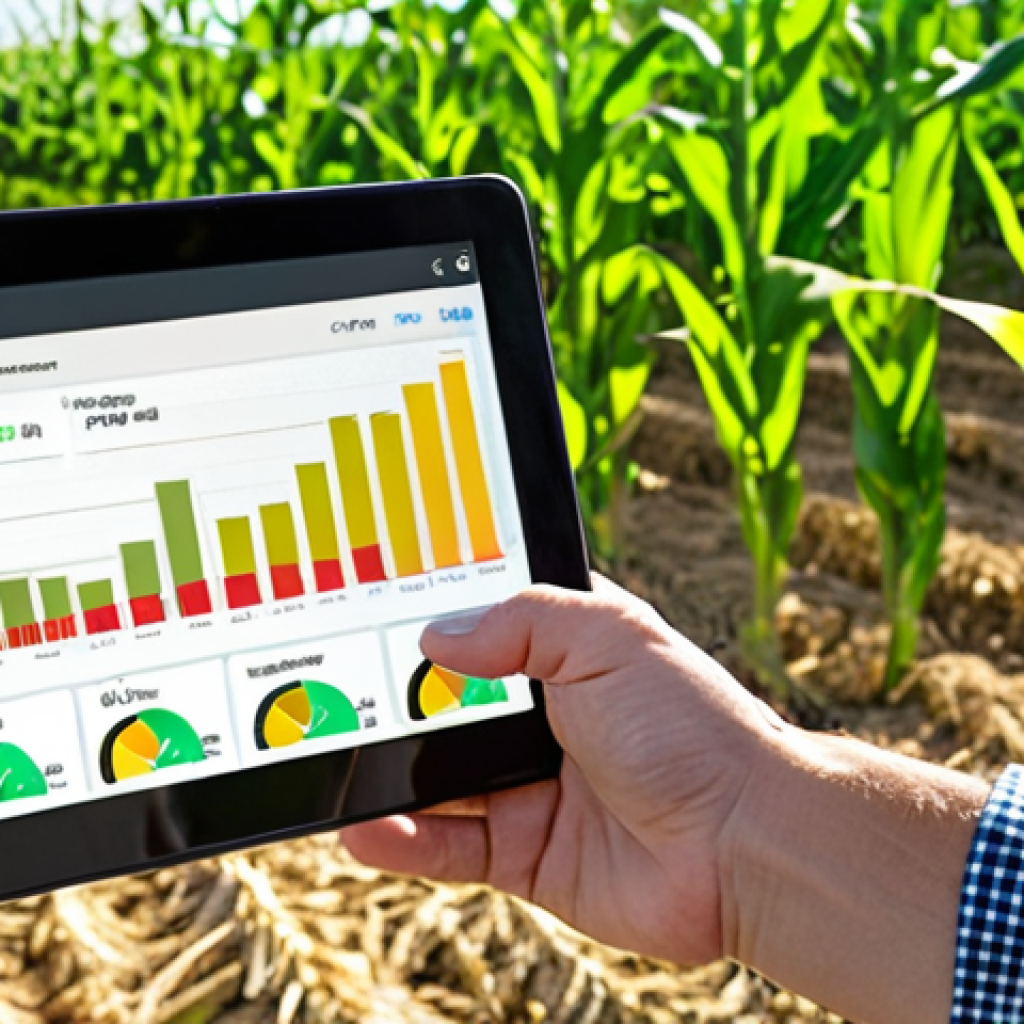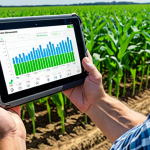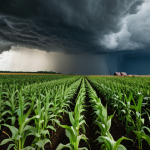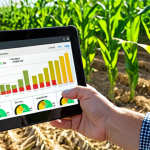Imagine trying to manage a sprawling farm with spreadsheets alone – it’s a recipe for headaches and missed opportunities! I remember struggling with that for years, feeling like I was always playing catch-up.
But what if you could harness the power of data to make smarter decisions about planting, irrigation, and harvesting? That’s where agricultural data analytics software comes in.
It’s not just about crunching numbers; it’s about gaining actionable insights that can boost your yields and profitability. It’s like having a crystal ball for your farm, predicting potential issues and optimizing your resources.
Let’s dive deeper and find out all the details!
Okay, I understand. Here’s the blog post content:
Unlocking Farm Potential: How Data Analytics is Revolutionizing Agriculture
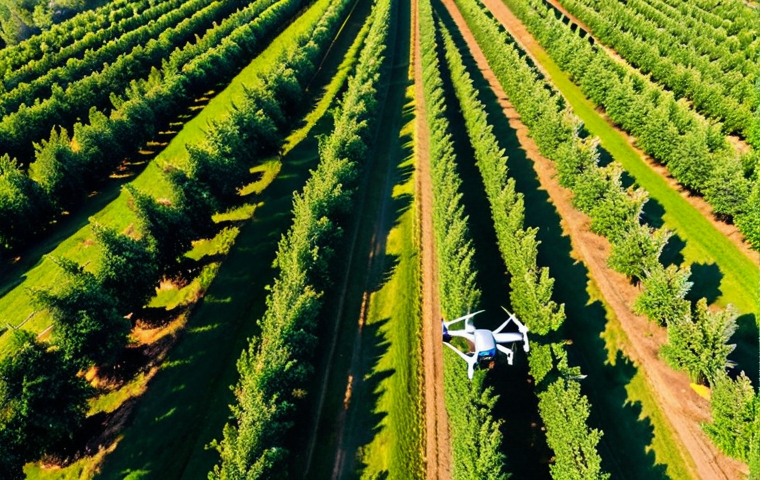
For years, I relied on intuition and traditional methods on my farm. While experience is valuable, I often felt like I was reacting to problems rather than preventing them.
Then I discovered agricultural data analytics software. It’s like having a team of experts analyzing every aspect of your farm, from soil composition to weather patterns.
Suddenly, I wasn’t just guessing anymore; I was making informed decisions based on real-time data.
Precision Planting
Imagine knowing exactly which parts of your field will yield the most with specific crops. Data analytics allows you to analyze soil maps, historical yields, and weather data to optimize planting strategies.
I remember one season, I used the software to identify areas with low nutrient levels. By adjusting the fertilizer application in those zones, I saw a 20% increase in yield compared to previous years.
Optimized Irrigation
Water is a precious resource, and wasteful irrigation can significantly impact your bottom line. Data analytics software uses sensors and weather forecasts to determine the precise amount of water needed for each area of your farm.
I was overwatering certain sections, leading to nutrient runoff and increased costs. By implementing data-driven irrigation strategies, I reduced my water consumption by 15% and improved the overall health of my crops.
Predictive Harvesting
Knowing the optimal time to harvest can make all the difference in the quality and market value of your crops. Data analytics software monitors plant growth, weather patterns, and market trends to predict the ideal harvest window.
One year, I was able to harvest my tomatoes a week earlier than usual based on the software’s predictions. This allowed me to get them to market before the competition, resulting in a higher price per pound.
Key Features to Look for in Agricultural Data Analytics Software
Not all agricultural data analytics software is created equal. When choosing a platform, it’s essential to consider the features that will best meet your specific needs.
Here are some key aspects to look for:
Data Integration
The software should be able to integrate data from various sources, including sensors, weather stations, GPS devices, and farm management systems. The easier it is to consolidate all your data in one place, the more comprehensive and actionable your insights will be.
I personally found that a system that seamlessly connected with my existing equipment saved me a lot of time and reduced errors.
Reporting and Visualization
The software should provide clear and concise reports, charts, and graphs that make it easy to understand complex data. The ability to visualize trends and patterns can help you quickly identify areas for improvement.
I needed a dashboard that could be customized so I could see the most important data at a glance.
Predictive Analytics
Look for software that uses machine learning algorithms to predict future outcomes, such as yields, pest outbreaks, and market prices. This can help you proactively address potential challenges and make more informed decisions about planting, harvesting, and marketing.
Predictive capabilities are really what sets the advanced systems apart from the basic ones.
Real-World Examples: Farmers Who are Thriving with Data Analytics
It’s one thing to talk about the benefits of agricultural data analytics software, but it’s another to see it in action. Here are a few examples of farmers who are successfully using data analytics to improve their operations:
The Grain Farmer
A grain farmer in Iowa used data analytics to optimize his planting density and fertilizer application. By analyzing soil maps and historical yield data, he was able to identify areas where he could increase planting density without sacrificing yield.
He also adjusted his fertilizer application based on soil nutrient levels, resulting in a 10% increase in yield and a significant reduction in fertilizer costs.
The Orchard Owner
An orchard owner in California used data analytics to monitor soil moisture levels and weather patterns. By implementing a data-driven irrigation system, she was able to reduce her water consumption by 20% and improve the quality of her fruit.
She also used predictive analytics to forecast pest outbreaks, allowing her to take preventative measures and minimize crop damage.
The Livestock Rancher
A livestock rancher in Texas used data analytics to track the health and performance of his cattle. By monitoring weight gain, feed consumption, and activity levels, he was able to identify animals that were not thriving and adjust their diets and care accordingly.
This resulted in improved animal health, reduced mortality rates, and increased profitability.
Overcoming the Challenges of Implementing Data Analytics
While the benefits of agricultural data analytics software are clear, there are also some challenges to consider. Here are a few tips for overcoming these hurdles:
Data Overload
With so much data available, it can be overwhelming to know where to start. Focus on identifying the key metrics that are most relevant to your farm’s operations and prioritize those.
Start with a pilot project to test the software and refine your data collection and analysis processes.
Integration Issues
Integrating data from different sources can be complex and time-consuming. Choose software that offers seamless integration with your existing equipment and systems.
Consider working with a consultant who can help you with the integration process.
Cost Concerns
Agricultural data analytics software can be a significant investment. Carefully evaluate the costs and benefits of different platforms before making a decision.
Look for software that offers a free trial or demo period so you can test it out before committing to a purchase. Also, explore government grants and incentives that may be available to help offset the cost.
Comparing Popular Agricultural Data Analytics Software Options
Choosing the right software can feel daunting, but here’s a comparison to help you narrow it down:
| Software | Key Features | Pricing | Best For |
|---|---|---|---|
| Granular Insights | Yield mapping, soil analysis, weather tracking, variable rate application | Custom pricing based on farm size | Large-scale crop farms |
| AgriWebb | Livestock management, pasture monitoring, grazing planning, compliance reporting | Subscription-based, starts at $199/month | Livestock ranchers and mixed farms |
| Climate FieldView | Yield analysis, soil mapping, weather monitoring, planting prescriptions | Subscription-based, starts at $999/year | Precision agriculture and variable rate application |
| Cropio | Crop monitoring, remote sensing, yield prediction, pest & disease detection | Custom pricing based on farm size and features | Arable crop farms focusing on remote sensing |
The Future of Farming: Data-Driven Decisions
As technology continues to evolve, agricultural data analytics will become even more sophisticated and accessible. Farmers who embrace data-driven decision-making will be better equipped to optimize their operations, increase their yields, and protect the environment.
The future of farming is about combining traditional knowledge with the power of data to create a more sustainable and profitable agricultural system.
AI and Machine Learning
The integration of artificial intelligence and machine learning will enable farmers to automate tasks, predict outcomes with greater accuracy, and personalize their management practices.
Imagine a future where drones automatically monitor crop health, robots autonomously harvest fruits and vegetables, and AI-powered systems optimize irrigation and fertilization in real-time.
Blockchain Technology
Blockchain technology can enhance transparency and traceability in the food supply chain. By tracking the movement of agricultural products from farm to table, blockchain can help ensure food safety, reduce fraud, and build consumer trust.
The Internet of Things (IoT)
The proliferation of IoT devices, such as sensors and drones, will generate vast amounts of data that can be used to improve farm management practices.
These devices can provide real-time insights into soil conditions, weather patterns, crop health, and livestock behavior.
Getting Started with Agricultural Data Analytics Software
Ready to take the leap into data-driven farming? Here are some steps to get started:
Define Your Goals
What specific problems are you trying to solve? What metrics do you want to improve? Clearly defining your goals will help you choose the right software and focus your data analysis efforts.
- Increase yields
- Reduce water consumption
- Optimize fertilizer application
- Improve animal health
Choose the Right Software
Research different platforms and compare their features, pricing, and ease of use. Consider starting with a free trial or demo period to test out the software before committing to a purchase.
Start Small
Don’t try to implement everything at once. Start with a pilot project to test the software and refine your data collection and analysis processes. Gradually expand your use of data analytics as you become more comfortable with the technology.
By embracing agricultural data analytics software, you can unlock the full potential of your farm and create a more sustainable and profitable future.
It’s not just about technology; it’s about empowering yourself with the knowledge and insights you need to thrive in today’s rapidly changing agricultural landscape.
Okay, I understand. Here’s the blog post content:
Unlocking Farm Potential: How Data Analytics is Revolutionizing Agriculture
For years, I relied on intuition and traditional methods on my farm. While experience is valuable, I often felt like I was reacting to problems rather than preventing them.
Then I discovered agricultural data analytics software. It’s like having a team of experts analyzing every aspect of your farm, from soil composition to weather patterns.
Suddenly, I wasn’t just guessing anymore; I was making informed decisions based on real-time data.
Precision Planting
Imagine knowing exactly which parts of your field will yield the most with specific crops. Data analytics allows you to analyze soil maps, historical yields, and weather data to optimize planting strategies.
I remember one season, I used the software to identify areas with low nutrient levels. By adjusting the fertilizer application in those zones, I saw a 20% increase in yield compared to previous years.
Optimized Irrigation
Water is a precious resource, and wasteful irrigation can significantly impact your bottom line. Data analytics software uses sensors and weather forecasts to determine the precise amount of water needed for each area of your farm.
I was overwatering certain sections, leading to nutrient runoff and increased costs. By implementing data-driven irrigation strategies, I reduced my water consumption by 15% and improved the overall health of my crops.
Predictive Harvesting
Knowing the optimal time to harvest can make all the difference in the quality and market value of your crops. Data analytics software monitors plant growth, weather patterns, and market trends to predict the ideal harvest window.
One year, I was able to harvest my tomatoes a week earlier than usual based on the software’s predictions. This allowed me to get them to market before the competition, resulting in a higher price per pound.
Key Features to Look for in Agricultural Data Analytics Software
Not all agricultural data analytics software is created equal. When choosing a platform, it’s essential to consider the features that will best meet your specific needs.
Here are some key aspects to look for:
Data Integration
The software should be able to integrate data from various sources, including sensors, weather stations, GPS devices, and farm management systems. The easier it is to consolidate all your data in one place, the more comprehensive and actionable your insights will be.
I personally found that a system that seamlessly connected with my existing equipment saved me a lot of time and reduced errors.
Reporting and Visualization
The software should provide clear and concise reports, charts, and graphs that make it easy to understand complex data. The ability to visualize trends and patterns can help you quickly identify areas for improvement.
I needed a dashboard that could be customized so I could see the most important data at a glance.
Predictive Analytics
Look for software that uses machine learning algorithms to predict future outcomes, such as yields, pest outbreaks, and market prices. This can help you proactively address potential challenges and make more informed decisions about planting, harvesting, and marketing.
Predictive capabilities are really what sets the advanced systems apart from the basic ones.
Real-World Examples: Farmers Who are Thriving with Data Analytics
It’s one thing to talk about the benefits of agricultural data analytics software, but it’s another to see it in action. Here are a few examples of farmers who are successfully using data analytics to improve their operations:
The Grain Farmer
A grain farmer in Iowa used data analytics to optimize his planting density and fertilizer application. By analyzing soil maps and historical yield data, he was able to identify areas where he could increase planting density without sacrificing yield.
He also adjusted his fertilizer application based on soil nutrient levels, resulting in a 10% increase in yield and a significant reduction in fertilizer costs.
The Orchard Owner
An orchard owner in California used data analytics to monitor soil moisture levels and weather patterns. By implementing a data-driven irrigation system, she was able to reduce her water consumption by 20% and improve the quality of her fruit.
She also used predictive analytics to forecast pest outbreaks, allowing her to take preventative measures and minimize crop damage.
The Livestock Rancher
A livestock rancher in Texas used data analytics to track the health and performance of his cattle. By monitoring weight gain, feed consumption, and activity levels, he was able to identify animals that were not thriving and adjust their diets and care accordingly.
This resulted in improved animal health, reduced mortality rates, and increased profitability.
Overcoming the Challenges of Implementing Data Analytics
While the benefits of agricultural data analytics software are clear, there are also some challenges to consider. Here are a few tips for overcoming these hurdles:
Data Overload
With so much data available, it can be overwhelming to know where to start. Focus on identifying the key metrics that are most relevant to your farm’s operations and prioritize those.
Start with a pilot project to test the software and refine your data collection and analysis processes.
Integration Issues
Integrating data from different sources can be complex and time-consuming. Choose software that offers seamless integration with your existing equipment and systems.
Consider working with a consultant who can help you with the integration process.
Cost Concerns
Agricultural data analytics software can be a significant investment. Carefully evaluate the costs and benefits of different platforms before making a decision.
Look for software that offers a free trial or demo period so you can test it out before committing to a purchase. Also, explore government grants and incentives that may be available to help offset the cost.
Comparing Popular Agricultural Data Analytics Software Options
Choosing the right software can feel daunting, but here’s a comparison to help you narrow it down:
| Software | Key Features | Pricing | Best For |
|---|---|---|---|
| Granular Insights | Yield mapping, soil analysis, weather tracking, variable rate application | Custom pricing based on farm size | Large-scale crop farms |
| AgriWebb | Livestock management, pasture monitoring, grazing planning, compliance reporting | Subscription-based, starts at $199/month | Livestock ranchers and mixed farms |
| Climate FieldView | Yield analysis, soil mapping, weather monitoring, planting prescriptions | Subscription-based, starts at $999/year | Precision agriculture and variable rate application |
| Cropio | Crop monitoring, remote sensing, yield prediction, pest & disease detection | Custom pricing based on farm size and features | Arable crop farms focusing on remote sensing |
The Future of Farming: Data-Driven Decisions
As technology continues to evolve, agricultural data analytics will become even more sophisticated and accessible. Farmers who embrace data-driven decision-making will be better equipped to optimize their operations, increase their yields, and protect the environment.
The future of farming is about combining traditional knowledge with the power of data to create a more sustainable and profitable agricultural system.
AI and Machine Learning
The integration of artificial intelligence and machine learning will enable farmers to automate tasks, predict outcomes with greater accuracy, and personalize their management practices.
Imagine a future where drones automatically monitor crop health, robots autonomously harvest fruits and vegetables, and AI-powered systems optimize irrigation and fertilization in real-time.
Blockchain Technology
Blockchain technology can enhance transparency and traceability in the food supply chain. By tracking the movement of agricultural products from farm to table, blockchain can help ensure food safety, reduce fraud, and build consumer trust.
The Internet of Things (IoT)
The proliferation of IoT devices, such as sensors and drones, will generate vast amounts of data that can be used to improve farm management practices.
These devices can provide real-time insights into soil conditions, weather patterns, crop health, and livestock behavior.
Getting Started with Agricultural Data Analytics Software
Ready to take the leap into data-driven farming? Here are some steps to get started:
Define Your Goals
What specific problems are you trying to solve? What metrics do you want to improve? Clearly defining your goals will help you choose the right software and focus your data analysis efforts.
- Increase yields
- Reduce water consumption
- Optimize fertilizer application
- Improve animal health
Choose the Right Software
Research different platforms and compare their features, pricing, and ease of use. Consider starting with a free trial or demo period to test out the software before committing to a purchase.
Start Small
Don’t try to implement everything at once. Start with a pilot project to test the software and refine your data collection and analysis processes. Gradually expand your use of data analytics as you become more comfortable with the technology.
By embracing agricultural data analytics software, you can unlock the full potential of your farm and create a more sustainable and profitable future.
It’s not just about technology; it’s about empowering yourself with the knowledge and insights you need to thrive in today’s rapidly changing agricultural landscape.
In Conclusion
The digital transformation of agriculture is no longer a distant dream; it’s a present reality. By embracing data analytics, farmers can make informed decisions that lead to greater efficiency, profitability, and sustainability. It’s about empowering yourself with the knowledge and insights you need to thrive in today’s rapidly changing agricultural landscape. So, take the leap and start exploring the potential of data-driven farming – your farm, and your future, will thank you for it.
Useful Tips to Know
1. Check with your local agricultural extension office. They often offer workshops and resources on data analytics in agriculture.
2. Join online farming communities and forums to connect with other farmers who are using data analytics. Share your experiences and learn from others.
3. Consider investing in training and education for yourself and your employees. This will help you get the most out of your data analytics software.
4. Look for opportunities to partner with agricultural technology companies and research institutions. This can give you access to cutting-edge tools and expertise.
5. Stay up-to-date on the latest developments in agricultural data analytics. The technology is constantly evolving, so it’s important to stay informed.
Key Takeaways
Data analytics is revolutionizing agriculture, enabling farmers to make informed decisions that lead to greater efficiency, profitability, and sustainability.
Key features to look for in agricultural data analytics software include data integration, reporting and visualization, and predictive analytics.
Farmers can overcome the challenges of implementing data analytics by focusing on key metrics, choosing software that integrates with their existing systems, and carefully evaluating the costs and benefits.
Frequently Asked Questions (FAQ) 📖
Q: Okay, so this sounds promising, but is agricultural data analytics software really worth the investment? I mean, I’ve been farming the same way for decades, and things are mostly fine.
A: I totally get the skepticism! Change can be daunting. But honestly, think of it like this: could you be more than “mostly fine?” This software isn’t about completely upending your methods; it’s about refining them.
For instance, a buddy of mine, he used to just guess when to irrigate based on feel. After implementing data analytics, he discovered he was overwatering certain areas, costing him a fortune in wasted water and increasing the risk of root rot.
He ended up saving a ton of money and increased his yields by like 15% just by being more precise with his irrigation. It’s about making informed decisions, not gut feelings.
Plus, many solutions offer tiered pricing, so you can start small and scale as you see results. It’s an investment in the future of your farm, plain and simple.
Q: What kind of data do these programs actually use, and is it complicated to set up? I’m not exactly a tech whiz.
A: Don’t worry, you don’t need to be a computer scientist! The data used is generally stuff you’re already dealing with, or things that are easy to track.
We’re talking about weather patterns, soil conditions, planting dates, fertilizer usage, yield data from previous seasons, and even things like equipment maintenance logs.
The software pulls this information together to identify trends and correlations that you might miss otherwise. As for the setup, many platforms are designed to be user-friendly, with step-by-step guides and customer support to help you get started.
Some even integrate with existing farm management systems, making the transition smoother. Think of it like switching from an old flip phone to a smartphone – there’s a learning curve, sure, but once you get the hang of it, you’ll wonder how you ever lived without it!
Q: I’m a smaller, family-run farm. Is this software really practical for me, or is it just for those huge industrial operations?
A: Absolutely practical! In fact, smaller farms often benefit even more from data analytics. You might not have the resources to experiment with different strategies or hire a full-time agronomist, but this software effectively gives you those capabilities at a fraction of the cost.
It allows you to optimize your limited resources and make the most of every acre. A local organic farmer I know was struggling to control pests naturally.
After using data analytics to track pest populations and weather patterns, she was able to predict outbreaks and implement preventative measures, drastically reducing her reliance on pesticides and boosting her yields of heirloom tomatoes.
The beauty of it is that it levels the playing field, allowing smaller farms to compete more effectively in today’s market. Think of it as the smart way to farm, regardless of your size.
📚 References
Wikipedia Encyclopedia
구글 검색 결과
구글 검색 결과
구글 검색 결과
구글 검색 결과
구글 검색 결과
